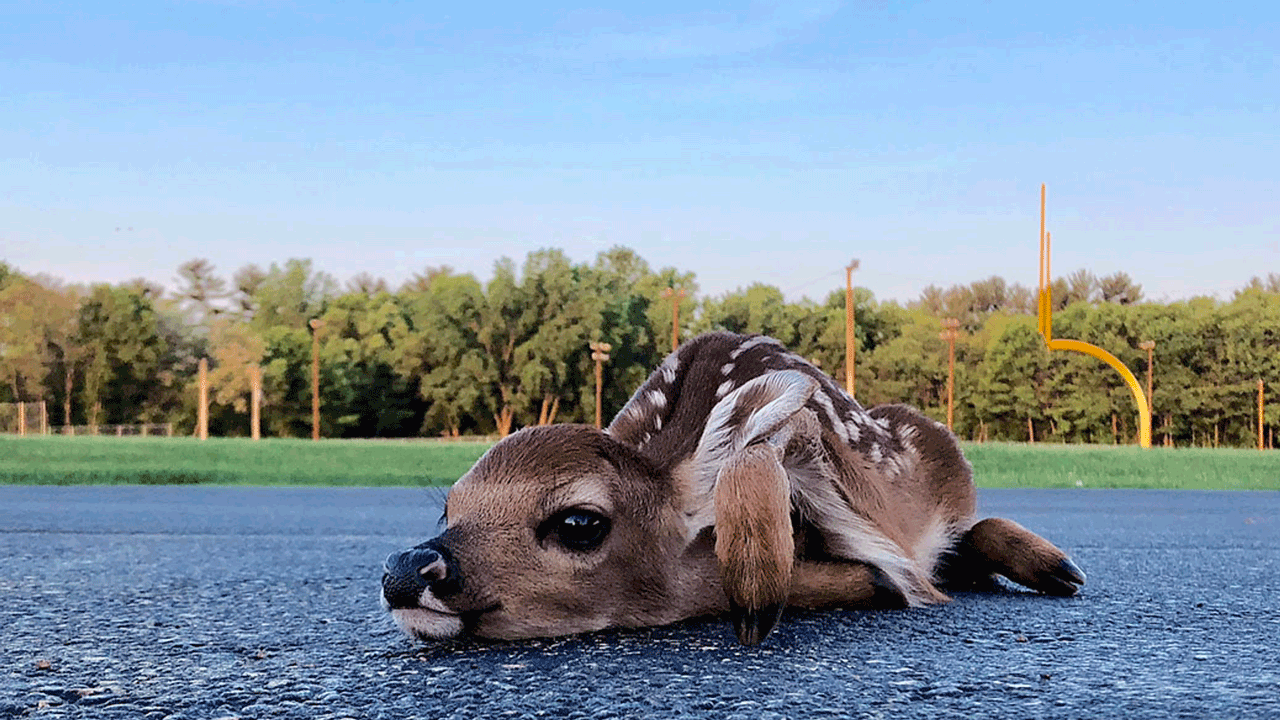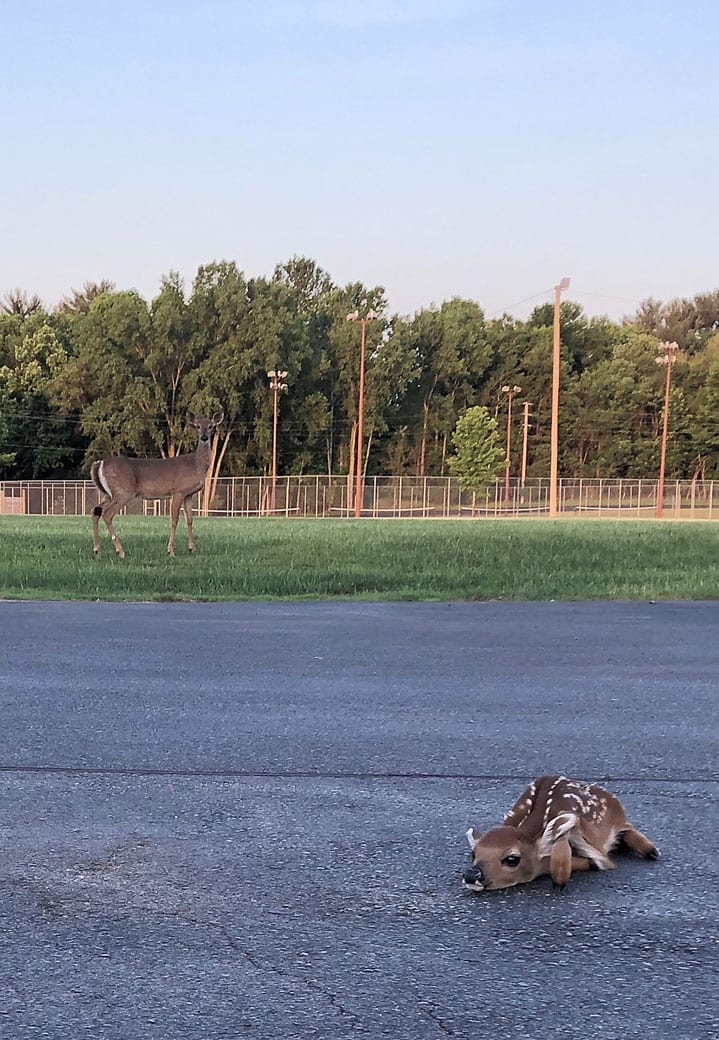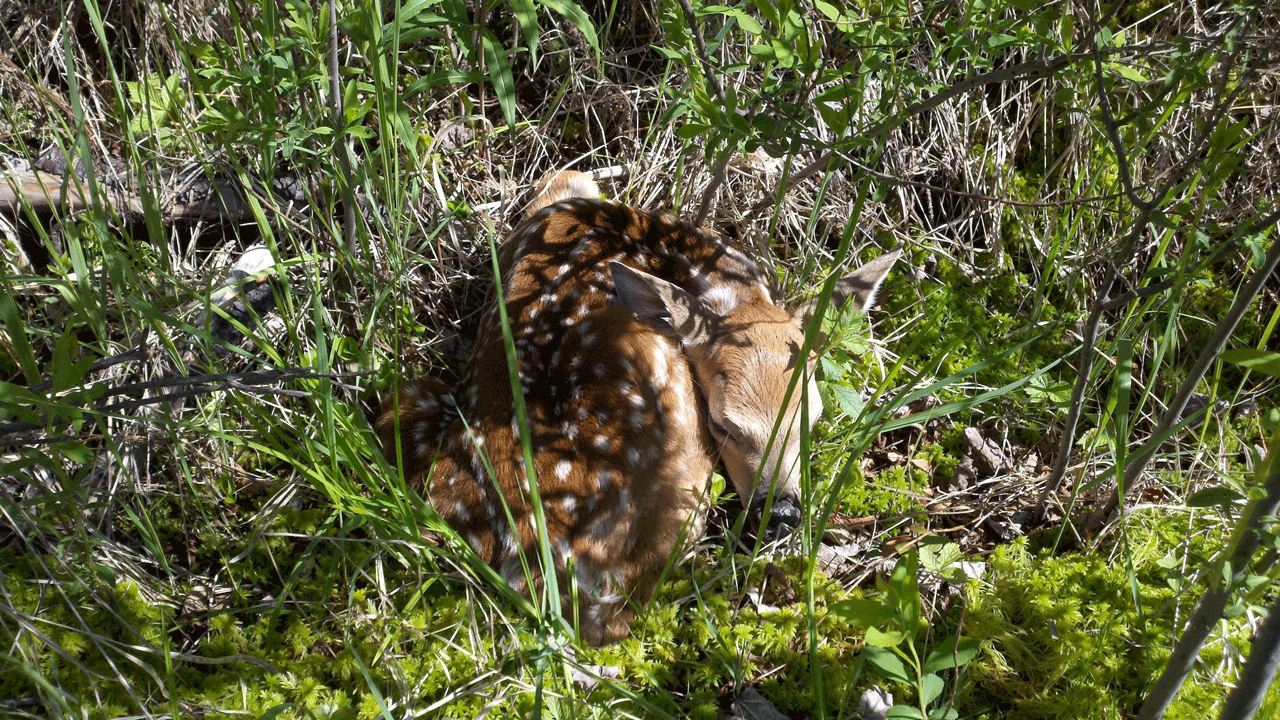If grandchildren hadn’t made me immune to death by cuteness, I’d have been a dead man before 6 a.m. one day in early June when spotting an infant fawn “hiding” atop an asphalt driveway in a schoolyard in central Wisconsin.
Seconds earlier I was trotting through the schoolyard on a fitness run when I saw a white-tailed doe nervously flicking her tail and ducking her head in the bus-only driveway 30 yards ahead. I kept running, thinking the doe would flee any second once identifying me as just another irritating human. For some reason, deer often seem confused by runners and let us get closer than usual.

A white-tailed fawn flattens itself onto a schoolyard driveway in central Wisconsin to await its mother’s return on a recent morning.
When the doe lifted her head to eyeball me, I saw spindly legs collapsing beneath her as a fawn flattened onto the pavement like freshly flopped horse apples. I slowed to a walk, wondering if I’d just witnessed a birth. The doe flipped up her tail, bounded onto the grass beyond, and then paused to watch as I stooped to inspect her fawn.

A white-tailed doe, background, watches after its wobbly legged fawn laid down to “hide” when seeing the author approaching.
Its reddish-brown coat with white-spotted lines looked dry and clean, so it wasn’t freshly born. Its big, dark eyes neither blinked nor followed me as I snapped pictures with my iPhone. If not for the subtle puffing of its nose and chest, the fawn could have passed for dead.
When I stood and resumed running, the doe fled into the nearby woods. When I looked back a minute later from farther away, I saw it walk back out of the woods. I kept running, figuring early-arriving teachers wouldn’t use the fawn’s driveway the next hour. That would give the doe time to coax its fawn into cover before the yellow buses rolled in.
After finishing my run and making coffee, I drove back to the schoolyard 90 minutes later. Cars and buses streamed bumper-to-bumper through the complex, confirming school was still in session. No one seemed to notice when I turned down the “Buses Only” driveway to confirm the fawn was gone. It was likely already flattened out in a better hiding spot in the woods, using its white-dappled hide as camouflage.
If you spend much time outdoors in late May through early June, you’ll eventually bump into a newborn fawn. White-tailed deer naturally synchronize their deliveries to swamp the landscape with so many fawns during one fortnight that predators can’t possibly eat all of them. After about three weeks of life, fawns can outrun most pursuers.
Bill Ishmael, a retired Department of Natural Resources wildlife manager in Wisconsin, said 1-week-old fawns easily outmaneuver humans. He knows that to be true because he and another biologist tried catching one a week earlier while tagging fawns for an ongoing research project on deer survival rates in southwestern Wisconsin.
“When our group tried circling it, that fawn broke past me and we chased after it,” Ishmael said. “It took off like an adult deer, running and jumping over logs and rocks. It probably looked comical, the two of us trying to catch it.”
The whitetail’s massive fawn-drop in late May/early June also helps trigger annual educational campaigns by wildlife agencies urging good Samaritans to leave baby wildlife alone. Most fawns, bunnies, fledglings, ducklings, goslings, raccoon kits and other young critters stand a better chance of surviving when we ignore them.
Unless the parent is lying dead nearby, it’s usually safe to assume it will return soon to tend to its offspring. Deer and other wildlife are not helicopter parents, forever hovering to prevent the inhumanity of skinned knees, bumped foreheads and unforced tumbles.
No, they monitor their offspring from a safe distance with their nose, ears and eyes; and stay within reach only long enough to feed and groom them. So, the sooner intruders disappear, the sooner the parent can resume parenting. If you insist on confirming the parent’s presence, hide a good distance downwind and watch with binoculars.
Scott Craven, a retired University of Wisconsin-Madison wildlife professor, said he spotted a newborn fawn stumbling through prairie grass near his driveway in early June after his dog stared intently in the fawn’s direction. The fawn went about 10 feet on its wobbly legs before flopping down to hide just beyond Craven’s lawn.

Few people can properly care for newborn fawns or other young wildlife and fledglings.
The time was 1 p.m. and temperatures exceeded 90 degrees, so Craven took his dog inside to think things over. “That set off a whole series of thoughts and discussions about what to do,” he said. “By the time my wife got home and we went outside to resolve the situation, it was gone. The situation resolved itself. All’s well that ends well. I just want to assume the doe and fawn will live happily ever after.”
Some young wildlife, of course, might require rescuing, such as when fledglings fall from a nest or fawns linger near busy roads. You might want to put on gloves, and then carry the fawn to nearby cover or lift the bird back into its nest. Next, leave quickly. The parent won’t care that you touched its young, despite what we’ve heard for generations about wildlife “rejecting” babies tainted by humans.
If you have questions about possibly orphaned wildlife, visit your state wildlife agency’s website and type “orphan” into the search window. From there you’ll likely find a “Keeping Wildlife Wild” page, which has instructions on what to do when finding young birds, fawns or other mammals. It also helps you determine if they’re truly orphaned.
Some fledglings and young wildlife require help from a certified rehabilitator. You’ll find their locations, specialties and contact information on the same website, or visit the agency’s main page and type “rehab” into the search window.
In all cases, do not claim ownership, and do not try raising fledglings or young wildlife yourself. It’s illegal and usually dooms the creature.
Just harden yourself to their cuteness and leave them alone. They can’t protect themselves from misguided love.

 By
By 



